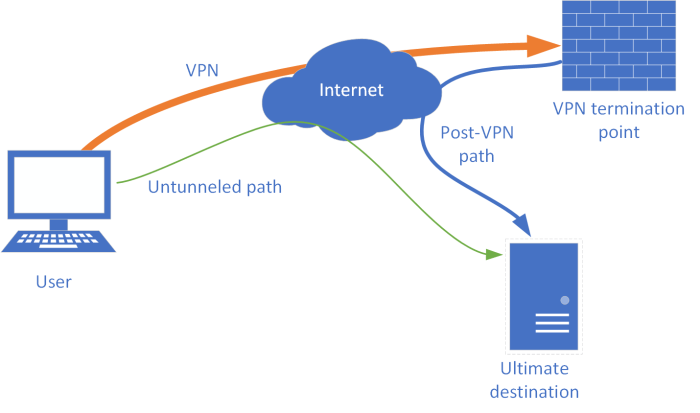In the ever-evolving world of cybersecurity, virtual private networks (VPNs) have emerged as indispensable tools for protecting our online privacy and securing our digital communications. Among the various VPN protocols, WireGuard stands out for its exceptional performance, enhanced security, and ease of use.
PiVPN, a popular open-source VPN solution, offers seamless integration with WireGuard, empowering users with a robust and versatile VPN experience.
This comprehensive guide will delve into the intricacies of PiVPN WireGuard split tunneling, providing you with a thorough understanding of its concepts, benefits, and practical applications. We will explore the fundamentals of VPNs, the advantages of WireGuard, and the art of configuring split tunneling with PiVPN.
Along the way, we will uncover troubleshooting tips, performance optimization techniques, and advanced configuration options to help you tailor your VPN experience to your specific needs.
VPN Fundamentals
A virtual private network (VPN) is a private network that allows users to securely access another network over the Internet. VPNs are often used to allow employees to securely access their company’s network from home or while traveling.
VPNs work by creating a secure tunnel between the user’s computer and the VPN server. All traffic that passes through this tunnel is encrypted, so it cannot be intercepted by unauthorized users.
There are many benefits to using a VPN, including:
- Increased security: VPNs protect your data from being intercepted by unauthorized users.
- Privacy: VPNs hide your IP address, so you can browse the Internet anonymously.
- Access to blocked content: VPNs allow you to access websites and content that is blocked in your country.
Types of VPN Protocols
There are many different VPN protocols available, each with its own advantages and disadvantages. Some of the most common VPN protocols include:
- IPsec: IPsec is a secure VPN protocol that is widely used by businesses and governments.
- OpenVPN: OpenVPN is an open-source VPN protocol that is known for its security and flexibility.
- PPTP: PPTP is a simple VPN protocol that is easy to set up and use, but it is not as secure as IPsec or OpenVPN.
- L2TP/IPsec: L2TP/IPsec is a VPN protocol that combines the security of IPsec with the simplicity of L2TP.
WireGuard Overview

WireGuard is a modern, open-source VPN protocol that aims to provide fast, secure, and easy-to-use virtual private networks.
It is designed to be more efficient and performant than traditional VPN protocols like OpenVPN and IPSec, and it also has a simpler configuration process.
Advantages of WireGuard
- Fast: WireGuard uses a modern cryptography algorithm that makes it much faster than other VPN protocols.
- Secure: WireGuard uses strong encryption algorithms to protect your data from eavesdropping.
- Easy to use: WireGuard has a simple configuration process that makes it easy to set up and use.
- Cross-platform: WireGuard is available for a wide range of operating systems, including Windows, macOS, Linux, iOS, and Android.
Disadvantages of WireGuard
- Relatively new: WireGuard is a relatively new protocol, and it may not be as widely supported as other VPN protocols.
- May require kernel modifications: WireGuard requires kernel modifications to work on some operating systems, which can be a barrier to adoption.
WireGuard vs. Other VPN Protocols
| Feature | WireGuard | OpenVPN | IPSec |
|---|---|---|---|
| Speed | Fast | Slow | Medium |
| Security | Strong | Strong | Strong |
| Ease of use | Easy | Medium | Difficult |
| Cross-platform | Yes | Yes | No |
Split Tunneling with PiVPN
Split tunneling is a VPN configuration that allows you to route only specific traffic through the VPN, while the rest of your traffic goes through your regular internet connection. This can be useful for several reasons, such as accessing local network resources while connected to the VPN or improving performance for certain types of traffic.
To set up split tunneling with PiVPN, you will need to edit the /etc/wireguard/wg0.conf file. Find the AllowedIPs line and add the IP addresses or subnets that you want to exclude from the VPN. For example, to exclude all traffic from the 192.168.1.0/24 subnet, you would add the following line:
AllowedIPs = 0.0.0.0/0, 192.168.1.0/24 You can also use split tunneling to route specific traffic through the VPN. For example, to route all traffic from the 192.168.1.0/24 subnet through the VPN, you would add the following line:
AllowedIPs = 192.168.1.0/24 Once you have made your changes, save the file and restart the WireGuard service. You can now test your split tunneling configuration by connecting to the VPN and checking that the traffic you want to exclude is not going through the VPN.
Examples of Split Tunneling
- Access local network resources while connected to the VPN. This can be useful for accessing printers, file servers, or other devices on your local network.
- Improve performance for certain types of traffic. For example, you could exclude gaming traffic from the VPN to reduce latency and improve performance.
- Bypass geo-restrictions. You could use split tunneling to access websites or services that are only available in certain countries.
Configuring PiVPN for WireGuard
PiVPN can be configured to use WireGuard, a modern and efficient VPN protocol. Follow these steps to set up PiVPN with WireGuard:
- 1.
- *Install PiVPN
“`bash curl
-L https
//install.pivpn.io | bash “`
- 2.
- *Select WireGuard
During the PiVPN installation, choose “WireGuard” as the VPN protocol.
- 3.
- *Generate WireGuard Keys
PiVPN will generate a private key and a public key for WireGuard. The private key should be kept secret, while the public key can be shared with clients.
- 4.
- *Configure PiVPN
Edit the `/etc/wireguard/wg0.conf` file and add the following lines: “` [Interface] Address = 10.6.0.1/24 ListenPort = 51820 PrivateKey = “`
Replace ` ` with the private key generated in step 3.
5. -*Add Allowed IPs
Edit the `/etc/iptables/rules.v4` file and add the following lines to allow traffic from the VPN subnet:
“`
-A INPUT -i wg0 -j ACCEPT
-A FORWARD -i wg0 -j ACCEPT
-A FORWARD -o wg0 -j ACCEPT “`
6. -*Restart PiVPN
“`bash sudo systemctl restart pivpn “`
7. -*Connect to PiVPN
On the client device, install a WireGuard client and import the public key generated in step 3. Connect to the VPN using the public IP address of the PiVPN server and port 51820.
Troubleshooting
* -*Cannot connect to the VPN: Verify that the WireGuard client is configured correctly and that the VPN server is running. – -*No internet access on the VPN: Ensure that the allowed IPs have been added to the firewall rules and that the client device is using the VPN as the default gateway.
– -*Slow VPN speeds: Check the network connection between the client device and the VPN server. Consider using a faster VPN protocol such as WireGuard.
Securing PiVPN with WireGuard
Securing PiVPN with WireGuard is crucial for protecting your network from unauthorized access and maintaining data privacy. WireGuard, known for its simplicity and performance, provides robust encryption and security features to safeguard your VPN connection.
To enhance the security of your PiVPN with WireGuard, consider the following best practices:
Strong Encryption
Employ strong encryption algorithms like ChaCha20 and Curve25519 to ensure data confidentiality and prevent unauthorized decryption.
Private Key Management
Handle private keys securely. Store them in a safe location, use strong passphrases, and consider hardware security modules (HSMs) for added protection.
Firewall Configuration
Configure your firewall to restrict access to the VPN server only through authorized ports and IP addresses. Limit access to the WireGuard port (default: 51820) and block unwanted traffic.
Regular Updates
Keep your PiVPN software and WireGuard packages up-to-date to patch security vulnerabilities and improve overall stability.
Monitoring and Logging
Implement monitoring and logging mechanisms to detect suspicious activity, identify security breaches, and facilitate troubleshooting.
Troubleshooting PiVPN WireGuard
Troubleshooting PiVPN WireGuard can be a challenging task, but there are several common problems that you may encounter, along with their solutions.
Below is a table that Artikels some of the most common problems and their solutions:
| Problem | Solution |
|---|---|
| Cannot connect to the VPN | – Ensure that the PiVPN server is running and accessible.
|
| Slow VPN speeds | – Check the network connection between the client and the server.
|
| DNS leaks | – Ensure that the client is using the PiVPN server’s DNS servers.
|
| IP address conflicts | – Ensure that the client and server are using different IP address ranges.
|
Performance Optimization

Enhancing the performance of your PiVPN WireGuard setup can elevate your user experience and ensure optimal network connectivity.
Implementing effective optimization techniques empowers you to enjoy faster speeds, improved reliability, and a more seamless VPN experience.
Adjusting MTU Settings
Fine-tuning the Maximum Transmission Unit (MTU) can significantly impact the performance of your PiVPN WireGuard connection. By optimizing the MTU, you can minimize packet fragmentation, which occurs when data packets exceed the maximum size allowed by the network. Packet fragmentation can lead to performance degradation, latency issues, and reduced overall efficiency.
To determine the optimal MTU for your network, you can utilize the “ping” command with the “-M do” flag. This command sends a series of packets with varying sizes and identifies the largest packet size that can be transmitted without fragmentation.
Once you have established the ideal MTU, configure it on both the PiVPN server and the client devices to align their packet sizes and enhance performance.
Selecting Optimal Encryption Algorithms
PiVPN WireGuard supports a range of encryption algorithms, each offering a distinct balance between security and performance. Selecting the most suitable encryption algorithm for your specific needs can optimize your VPN’s performance without compromising its security.
For scenarios where speed is paramount, ChaCha20 can be an excellent choice. This algorithm is known for its high performance and low computational overhead, making it ideal for devices with limited processing power or bandwidth constraints.
In situations where security is a top priority, AES-256 can be employed. This algorithm provides robust encryption with minimal performance impact, ensuring a secure and reliable connection.
Tuning Kernel Parameters
Adjusting specific kernel parameters can further enhance the performance of your PiVPN WireGuard setup. These parameters govern various aspects of the kernel’s networking behavior, and optimizing them can yield noticeable improvements in speed and reliability.
One key parameter is “net.core.default_qdisc,” which controls the default queuing discipline for network interfaces. By setting this parameter to “fq_codel,” you can implement a sophisticated queuing algorithm that optimizes packet scheduling and minimizes latency.
Additionally, increasing the value of “net.ipv4.tcp_rmem” and “net.ipv4.tcp_wmem” can improve the performance of TCP connections over the VPN. These parameters determine the size of the receive and send buffers for TCP connections, allowing for more efficient handling of data.
Advanced Configuration
PiVPN WireGuard offers a wide range of advanced configuration options to customize the VPN according to specific requirements.
These options provide granular control over the VPN’s behavior, enabling users to optimize performance, enhance security, and adapt the VPN to unique network environments.
Customizing Network Settings
- Configure custom IP addresses and subnets for the VPN interface.
- Specify the allowed IP ranges for the VPN tunnel, limiting access to specific networks or hosts.
- Enable or disable IPv6 support for the VPN connection.
Security Enhancements
- Configure strong encryption algorithms and key sizes to protect data in transit.
- Enable perfect forward secrecy to prevent attackers from decrypting past traffic even if the encryption key is compromised.
- Set up a kill switch to automatically block internet access outside the VPN tunnel, ensuring data protection even in case of VPN connection failure.
Performance Optimization
- Adjust MTU (Maximum Transmission Unit) settings to optimize data transfer performance over specific network links.
- Configure custom DNS servers to improve name resolution and reduce latency.
- Enable or disable IP forwarding to control how the VPN handles traffic destined for other networks.
Advanced Split Tunneling
- Create multiple split tunneling rules to route specific traffic through the VPN tunnel while excluding others.
- Configure per-client split tunneling rules to customize VPN behavior for individual users or devices.
- Use advanced firewall rules to further control traffic flow and enhance security.
Real-World Applications

PiVPN WireGuard has a wide range of practical applications in various scenarios.
Use Cases and Applications
- Secure Remote Access: PiVPN WireGuard enables secure remote access to private networks, allowing users to securely connect to their home or office networks from anywhere with an internet connection.
- Bypassing Geo-Restrictions: PiVPN WireGuard can be used to bypass geo-restrictions and access region-locked content or services. By connecting to a server in a different region, users can access content that is normally unavailable in their location.
- Enhanced Privacy: PiVPN WireGuard provides enhanced privacy by encrypting internet traffic, making it difficult for third parties to monitor or intercept online activities.
- Secure Public Wi-Fi Connections: PiVPN WireGuard can be used to secure public Wi-Fi connections, protecting users from eavesdropping or man-in-the-middle attacks.
Benefits and Limitations
Benefits
- Strong Encryption: PiVPN WireGuard uses state-of-the-art encryption algorithms, providing robust protection against eavesdropping and unauthorized access.
- Fast and Efficient: PiVPN WireGuard is highly optimized for performance, offering fast and reliable connections.
- Cross-Platform Compatibility: PiVPN WireGuard supports a wide range of devices and operating systems, including Windows, macOS, Linux, Android, and iOS.
Limitations
- Limited Device Support: PiVPN WireGuard may not be supported on all devices, especially older or less powerful ones.
- Firewall Configuration: Setting up PiVPN WireGuard may require firewall configuration, which can be challenging for non-technical users.
Future Developments
The future of PiVPN WireGuard is promising, with numerous improvements and new features on the horizon. These advancements will significantly enhance the VPN’s capabilities, security, and user experience.
The PiVPN WireGuard team is actively working on several exciting developments, including:
Performance Optimization
- Continued performance optimizations to improve connection speeds and reduce latency.
- Implementation of new techniques to minimize overhead and maximize efficiency.
Security Enhancements
- Advanced encryption algorithms to strengthen data protection.
- Improved key management and authentication mechanisms to prevent unauthorized access.
Usability Improvements
- Simplified configuration process for easier setup and management.
- Enhanced user interface for a more intuitive and user-friendly experience.
Integration with Other Technologies
- Seamless integration with other network technologies, such as OpenVPN and IPsec.
- Support for a wider range of devices and platforms.
Roadmap for PiVPN WireGuard
The PiVPN WireGuard team is committed to delivering these advancements through a well-defined roadmap. Regular updates and releases will ensure that users have access to the latest features and improvements. The roadmap includes milestones for performance optimization, security enhancements, usability improvements, and integration with other technologies.
By staying up-to-date with the latest developments, PiVPN WireGuard users can leverage the full potential of this powerful VPN solution and enjoy a secure, private, and high-performance online experience.
Conclusion
Mastering PiVPN WireGuard split tunneling empowers you with unparalleled control over your network traffic, enabling you to navigate the digital landscape with confidence and security. By understanding the concepts Artikeld in this guide, you can harness the full potential of this powerful VPN solution to safeguard your privacy, optimize your network performance, and unlock a world of secure and unrestricted online experiences.